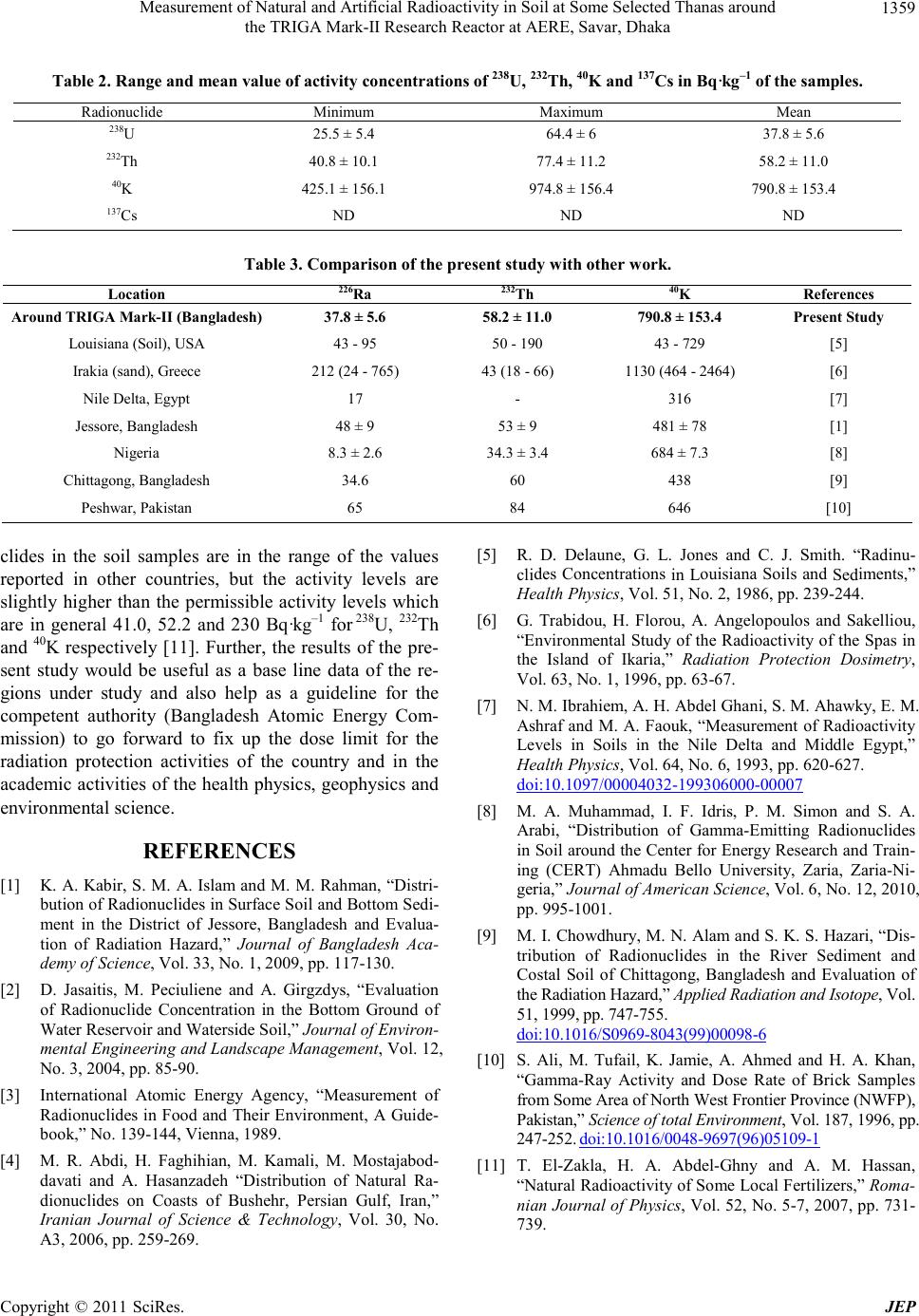
Measurement of Natural and Artificial Radioactivity in Soil at Some Selected Thanas around 1359
the TRIGA Mark-II Research Reacto r at AERE, Savar, Dhaka
ns Table 2. Rang e and mea n value of activit y concentrat ioof 238U, 232Th, 40K and 137Cs in Bq·kg–1 of the samples.
Radionuclide Minimum Maximum Mean
238U 25.5 ± 5.4 64.4 ± 6 37.8 ± 5.6
232Th 40.8 ± 10.1 77.4 ± 11.2 58.2 ± 11.0
40K
137
421 97790.3.4 5.1 ± 15 6.4.8 ± 15 6.4 8 ± 15
Cs ND ND ND
Table 3.n of the present st udork.
ion 232Th 40K Rces
Comparisoy with other w
Locat 226 Ra eferen
Around TRIGA k-II (Bangladesh) 3 5.6 58.2 ± 11.0 790.8 ± 153.4 sent Study Mar7.8 ±Pre
Louisiana (Soi l), USA 729 [5]
Irakia (reece 212 (5) 43 (6) 1130 (4 2464)
Chh
43 - 95 50 - 190 43 -
sand), G24 - 7618 - 664 -[6]
Nile Delta, Egypt 17 - 316 [7]
Jes sore, Bang lades h 48 ± 9 53 ± 9 481 ± 78 [1]
Nigeria 8.3 ± 2.6 34.3 ± 3.4 684 ± 7.3 [8]
ittag o ng, Bang lades34 .6 60 438 [9]
Peshwar, Pakistan 65 84 646 [10]
clides in the soples are in the range ovalues
reported but the activitvels are
slightly hirmissible activity ls which
re in general 41.0, 52.2 and 230 Bq·kg–1 for 238U, 232Th
s in Surface Soil and Bottom Sedi-
ment in the Dladesh and Evalua-
tion of Radiatf Bangladesh Aca-
ian, M. Kamali, M. Mostajabod-
[ Delaune, G and C. J. Smith. “Radinu-
des Concentrationsouisiana Soils andiments,”
alth Physics, Vol. o. 2, 1986, pp. 23.
[6] G. Trabidou, H. Florou, A. Angelopoulos and Sakelliou,
bd e l Gha n i , S . M. Ahaw k y, E . M.
il samf the
in other countries,y le
gher than the peleve
a
and 40K respectively [11]. Further, the results of the pre-
sent study would be useful as a base line data of the re-
gions under study and also help as a guideline for the
competent authority (Bangladesh Atomic Energy Com-
mission) to go forward to fix up the dose limit for the
radiation protection activities of the country and in the
academic activities of the health physics, geophysics and
environmental science.
REFERENCES
[1] K. A. Kabir, S. M. A. Islam and M. M. Rahman, “Distri-
bution of Radionuclide
istrict of Jessore, Bang
ion Hazard,” Journal o
demy of Science, Vol. 33, No. 1, 200 9, pp. 117-13 0.
[2] D. Jasaitis, M. Peciuliene and A. Girgzdys, “Evaluation
of Radionuclide Concentration in the Bottom Ground of
Water Reservoir and Waterside Soil,” Journal of Environ-
mental Engineering and Landscape Management, Vol. 12,
No. 3, 2004, pp. 85-90.
[3] International Atomic Energy Agency, “Measurement of
Radionuclides in Food and Their Environment, A Guide-
book,” No. 139-144, Vienna, 1989.
[4] M. R. Abdi, H. Faghih
davati and A. Hasanzadeh “Distribution of Natural Ra-
dionuclides on Coasts of Bushehr, Persian Gulf, Iran,”
Iranian Journal of Science & Technology, Vol. 30, No.
A3, 2006, pp. 259-269.
“Environmental Study of the Radioactivity of the Spas in
the Island of Ikaria,” Radiation Protection Dosimetry,
Vol. 63, No. 1, 1996, pp. 63-67.
[7] N. M . I b r a h i e m, A. H . A
5] R. D.. L. Jones
cli in L Sed
He 51, N9-244
Ashraf and M. A. Faouk, “Measurement of Radioactivity
Levels in Soils in the Nile Delta and Middle Egypt,”
Health Physics, Vol. 64, No. 6, 1993, pp. 620-627.
do i:10.1097/00004032-199306000-00007
[8] M. A. Muhammad, I. F. Idris, P. M. Simon and S. A.
Arabi, “Distribution of Gamma-Emitting Radionuclides
in Soil around the Center for E nergy Research and Train -
ing (CERT) Ahmadu Bello University, Zaria, Zaria-Ni-
geria,” Journal of American Science, Vol. 6, No. 12, 2010,
pp. 995- 1 00 1.
[9] M. I. Chowdhury, M. N. Alam an d S. K. S. Hazari, “Dis-
tribution of Radionuclides in the River Sediment and
Costal Soil of Chittagong, Bangladesh and Evaluation of
the Radia tion Ha za r d,” Applie d Radiation and Isotope, V ol.
51, 1999, pp. 7 47- 7 55.
doi:10.1016/S0969-8043(99)00098-6
[10] S. Ali, M. Tufail, K. Jamie, A. Ahmed and H. A. Khan,
“Gamma-Ray Activity and Dose Rate of Brick Samples
from Some Area of North West Frontier Province (NWFP),
Pakistan,” Science of total Environment, Vol. 187, 1996, pp.
247-252. doi:10.1016/0048-9697(96)05109-1
[11] T. El-Zakla, H. A. Abdel-Ghny and A. M. Hassan,
“Natural Radioactivity of Some Local Fertilizers,” Roma-
nian Journal of Physics, Vol. 52, No. 5-7, 2007, pp. 731-
739.
Copyright © 2011 SciRes. JEP